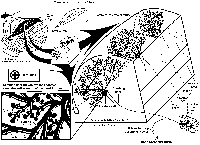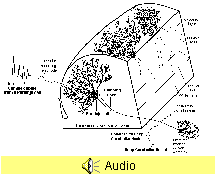Circuitry
Folia
 Lets now schematize the
basics of the internal cerebellar circuitry. First, we can
look at an old friend who we first met at level 3 in the
brain stem-THE INFERIOR OLIVE. Remember, I told you
that cells in the olive have axons that pass to the
contralateral cerebellum as climbing fibers. These
fibers go to all parts of the cerebellum, that is, they are
not restricted to a particular zone. The drawing above shows
that a climbing fiber sends a collateral to the deep
cerebellar nuclei, which is excitatory, and then "climbs"up
and like ivy, entwines and synapses all over the dendrites
of the Purkinje cell. Each Purkinje cell receives input from
only 1 climbing fiber axon, but each climbing fiber
axon can split to innervate several Purkinje cells.
These climbing fiber-Purkinje cell synapses are
excitatory.
Lets now schematize the
basics of the internal cerebellar circuitry. First, we can
look at an old friend who we first met at level 3 in the
brain stem-THE INFERIOR OLIVE. Remember, I told you
that cells in the olive have axons that pass to the
contralateral cerebellum as climbing fibers. These
fibers go to all parts of the cerebellum, that is, they are
not restricted to a particular zone. The drawing above shows
that a climbing fiber sends a collateral to the deep
cerebellar nuclei, which is excitatory, and then "climbs"up
and like ivy, entwines and synapses all over the dendrites
of the Purkinje cell. Each Purkinje cell receives input from
only 1 climbing fiber axon, but each climbing fiber
axon can split to innervate several Purkinje cells.
These climbing fiber-Purkinje cell synapses are
excitatory.
 Since climbing fibers
have synapses all over the dendritic tree of a Purkinje
cell, their total excitatory action is extremely strong. In
fact, the synaptic connection between the climbing fiber and
the Purkinje cell is one of the most powerful in the nervous
system. A single action potential in a climbing fiber
elicits a burst of action potentials in the Purkinje
cells that it contacts. This burst of action potentials
exhibited by a Purkinje cell is called a complex
spike. Climbing fibers are "lazy" (but strong), thus
Purkinje cells exhibit complex spikes at a rate of about 1
per second. The illustration above depicts an intracellular
recording from a Purkinje cell that has just been turned on
by stimulating the climbing fiber a single time. This single
climbing fiber stimulus has a powerful effect in that it
results in 4 action potentials (i.e., complex
spike) of varying amplitudes in the Purkinje cell.
Since climbing fibers
have synapses all over the dendritic tree of a Purkinje
cell, their total excitatory action is extremely strong. In
fact, the synaptic connection between the climbing fiber and
the Purkinje cell is one of the most powerful in the nervous
system. A single action potential in a climbing fiber
elicits a burst of action potentials in the Purkinje
cells that it contacts. This burst of action potentials
exhibited by a Purkinje cell is called a complex
spike. Climbing fibers are "lazy" (but strong), thus
Purkinje cells exhibit complex spikes at a rate of about 1
per second. The illustration above depicts an intracellular
recording from a Purkinje cell that has just been turned on
by stimulating the climbing fiber a single time. This single
climbing fiber stimulus has a powerful effect in that it
results in 4 action potentials (i.e., complex
spike) of varying amplitudes in the Purkinje cell.